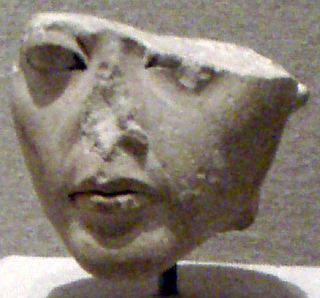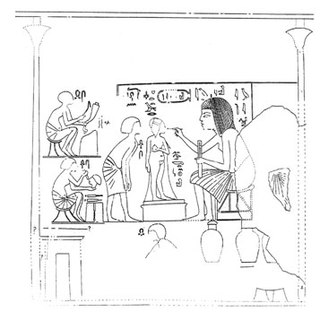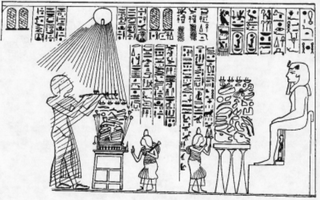Related Research Articles

Aten also Aton, Atonu, or Itn was the focus of Atenism, the religious system established in ancient Egypt by the Eighteenth Dynasty pharaoh Akhenaten. The Aten was the disc of the sun and originally an aspect of Ra, the sun god in traditional ancient Egyptian religion. Akhenaten, however, made it the sole focus of official worship during his reign. In his poem "Great Hymn to the Aten", Akhenaten praises Aten as the creator, giver of life, and nurturing spirit of the world. Aten does not have a creation myth or family but is mentioned in the Book of the Dead. The worship of Aten was initially dismantled by Tutankhamun and later eradicated by Tutankhamun's former military general Horemheb.

Amarna is an extensive Egyptian archaeological site containing the remains of what was the capital city of the late Eighteenth Dynasty. The city was established in 1346 BC, built at the direction of the Pharaoh Akhenaten, and abandoned shortly after his death in 1332 BC. The name that the ancient Egyptians used for the city is transliterated in English as Akhetaten or Akhetaton, meaning "the horizon of the Aten".

Neferneferuaten Nefertiti was a queen of the 18th Dynasty of Ancient Egypt, the great royal wife of Pharaoh Akhenaten. Nefertiti and her husband were known for a religious revolution, in which they worshipped solely the sun disc, Aten, as the only god. With her husband, she reigned at what was arguably the wealthiest period of ancient Egyptian history. Some scholars believe that Nefertiti ruled briefly as Neferneferuaten after her husband's death and before the ascension of Tutankhamun, although this identification is a matter of ongoing debate. If Nefertiti did rule as Pharaoh, her reign was marked by the fall of Amarna and relocation of the capital back to the traditional city of Thebes.

Smenkhkare was an ancient Egyptian pharaoh of unknown background who lived and ruled during the Amarna Period of the 18th Dynasty. Smenkhkare was husband to Meritaten, the daughter of his likely co-regent, Akhenaten. Very little is known of Smenkhkare for certain because later kings sought to erase the Amarna Period from history. Because of this, perhaps no one from the Amarna Interlude has been the subject of so much speculation as Smenkhkare.

Meritaten, also spelled Merytaten, Meritaton or Meryetaten, was an ancient Egyptian royal woman of the Eighteenth Dynasty of Egypt. Her name means "She who is beloved of Aten"; Aten being the sun-deity whom her father, Pharaoh Akhenaten, worshipped. She held several titles, performing official roles for her father and becoming the Great Royal Wife to Pharaoh Smenkhkare, who may have been a brother or son of Akhenaten. Meritaten also may have served as pharaoh in her own right under the name Ankhkheperure Neferneferuaten.

Ankhesenamun was a queen who lived during the 18th Dynasty of Egypt as the pharaoh Akhenaten's daughter and subsequently became the Great Royal Wife of pharaoh Tutankhamun. Born Ankhesenpaaten, she was the third of six known daughters of the Egyptian Pharaoh Akhenaten and his Great Royal Wife Nefertiti. She became the Great Royal Wife of Tutankhamun. The change in her name reflects the changes in ancient Egyptian religion during her lifetime after her father's death. Her youth is well documented in the ancient reliefs and paintings of the reign of her parents. The mummy of Tutankhamun's mother has been identified through DNA analysis as a full sister to his father, the unidentified mummy found in tomb KV55, and as a daughter of his grandfather, Amenhotep III. So far his mother's name is uncertain, but her mummy is known informally to scientists as the Younger Lady.

Panehesy was an Egyptian noble who bore the titles of 'Chief servitor of the Aten in the temple of Aten in Akhetaten'.

The Great Temple of the Aten was a temple located in the city of el-Amarna, Egypt. It served as the main place of worship of the deity Aten during the reign of the 18th Dynasty pharaoh Akhenaten. Akhenaten ushered in a unique period of ancient Egyptian history by establishing the new religious cult dedicated to the sun-disk Aten, originally an aspect of Ra, the sun god in traditional ancient Egyptian religion. The king shut down traditional worship of other deities like Amun-Ra, and brought in a new era, though short-lived, of seeming monotheism where the Aten was worshipped as a sun god and Akhenaten and his wife, Nefertiti, represented the divinely royal couple that connected the people with the god. Although he began construction at Karnak during his rule, the association the city had with other gods drove Akhenaten to establish a new city and capital at Amarna for the Aten. Akhenaten built the city along the east bank of the Nile River, setting up workshops, palaces, suburbs and temples. The Great Temple of the Aten was located just north of the Central City and, as the largest temple dedicated to the Aten, was where Akhenaten fully established the proper cult and worship of the sun-disk.

The Small Aten Temple is a temple to the Aten located in the ancient Egyptian city of Amarna. It is one of the two major temples in the city, the other being the Great Temple of the Aten. It is situated next to the King's House and near the Royal Palace, in the central part of the city. Original known as the Hwt-Jtn or Mansion of the Aten, it was probably constructed before the larger Great Temple. Its only contemporary depiction is found in the tomb of Tutu. Like the other structures in the city, it was constructed quickly, and hence was easy to dismantle and reuse the material for later construction.

Neferneferuaten Tasherit or Neferneferuaten the younger was an ancient Egyptian princess of the 18th Dynasty and the fourth daughter of Pharaoh Akhenaten and his Great Royal Wife Nefertiti.

Neferneferure was an ancient Egyptian princess of the 18th Dynasty. She was the fifth of six known daughters of Pharaoh Akhenaten and his Great Royal Wife Nefertiti.

Beketaten (14th century BCE) was an ancient Egyptian princess of the 18th Dynasty. Beketaten is considered to be the youngest daughter of Pharaoh Amenhotep III and his Great Royal Wife Tiye, thus the sister of Pharaoh Akhenaten. Her name means "Handmaid of Aten".
The North City was an administrative area in the ancient Egyptian city of Amarna in Upper Egypt, the short-lived capital of Pharaoh Akhenaten of the 18th Dynasty. It contains the ruins of royal palaces, especially the Northern Palace and other administrative buildings and occupies an area between the river and the cliffs that terminate the plains to the north of the city itself.

Bek or Bak was the first chief royal sculptor during the reign of Pharaoh Akhenaten. His father Men held the same position under Akhenaten's father Amenhotep III; his mother Roi was a woman from Heliopolis.
The use of urban planning in ancient Egypt is a matter of continuous debate. Because ancient sites usually survive only in fragments, and many ancient Egyptian cities have been continuously inhabited since their original forms, relatively little is actually understood about the general designs of Egyptian towns for any given period.

Setepenre or Sotepenre was an ancient Egyptian princess of the 18th Dynasty; sixth and last daughter of Pharaoh Akhenaten and his chief queen Nefertiti.

The Northern Palace, also called the North Palace, is located in the abandoned Northern Suburbs of the city of Ahketaten. This palace should not be confused with the North Riverside Palace further north in Amarna.
Nakhtpaaten or Nakht was an ancient Egyptian vizier during the reign of Pharaoh Akhenaten of the 18th Dynasty.

Amarna Tomb 3 is a rock-cut cliff tomb located in Amarna, Upper Egypt. The tomb belonged to the Ancient Egyptian noble Ahmes (Ahmose), who served during the reign of Akhenaten. The tomb is situated at the base of a steep cliff and mountain track at the north-eastern end of the Amarna plains. It is located in the northern side of the wadi that splits the cluster of graves known collectively as the Northern tombs. Amarna Tomb 3 is one of six elite tombs belonging to the officials of Akhenaten. It was one of the first Northern tombs, built in Year 9 of the reign of Akhenaten.

May was an ancient Egyptian official during the reign of Pharaoh Akhenaten. He was Royal chancellor and fan-bearer at Akhet-Aten, the pharaoh's new capital. He was buried in Tomb EA14 in the southern group of the Amarna rock tombs. Norman de Garis Davies originally published details of the Tomb in 1908 in the Rock Tombs of El Amarna, Part V – Smaller Tombs and Boundary Stelae. The tomb dates to the late 18th Dynasty.
References
- ↑ Reeves, Nicholas. Akhenaten: Egypt's False Prophet. Thames & Hudson. 2005. ISBN 0-500-285527
- 1 2 3 Kemp, Barry, The City of Akhenaten and Nefertiti: Amarna and its People, Thames and Hudson, 2012
- ↑ Amarna Project | North City with description of North Riverside Palace
- ↑ Rolf Gundlach and John H Taylor, 4th Symposium on Egyptian Royal Ideology Egyptian Royal Residences: London, June 1st-5th 2004, Harrassowitz Verlag, 2009
